Business Ethics: Lesson Planning for Professional Development
VerifiedAdded on 2023/06/14
|17
|5358
|163
Report
AI Summary
This report provides a detailed analysis of lesson planning, focusing on business ethics within a professional development context. It explores the aims and characteristics of effective lesson plans, emphasizing the incorporation of learner goals and needs, learning styles, and taxonomies. The report further discusses strategies for ensuring inclusivity, preparing effective lesson plans, and the importance of flexibility and adaptability. It includes a sample lesson plan and delves into assessment and evaluation methods, highlighting the use of differentiated assessments to cater to individual learner needs. The analysis of assessment results informs future lesson planning, ensuring continuous improvement and alignment with learner progress and achievements. This resource is designed to aid educators in creating impactful and inclusive learning experiences. Desklib provides a platform to explore more such assignments.
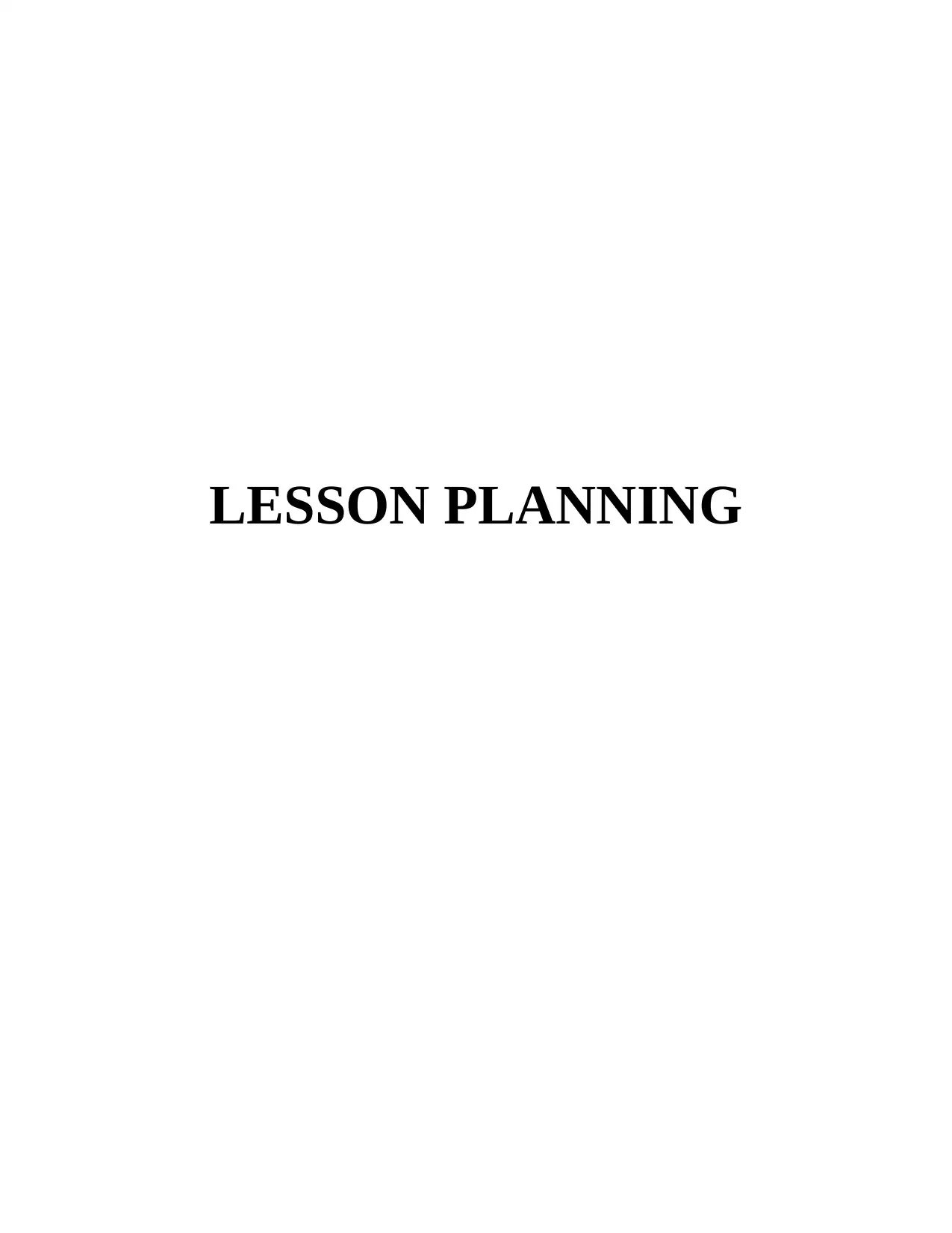
LESSON PLANNING
Paraphrase This Document
Need a fresh take? Get an instant paraphrase of this document with our AI Paraphraser
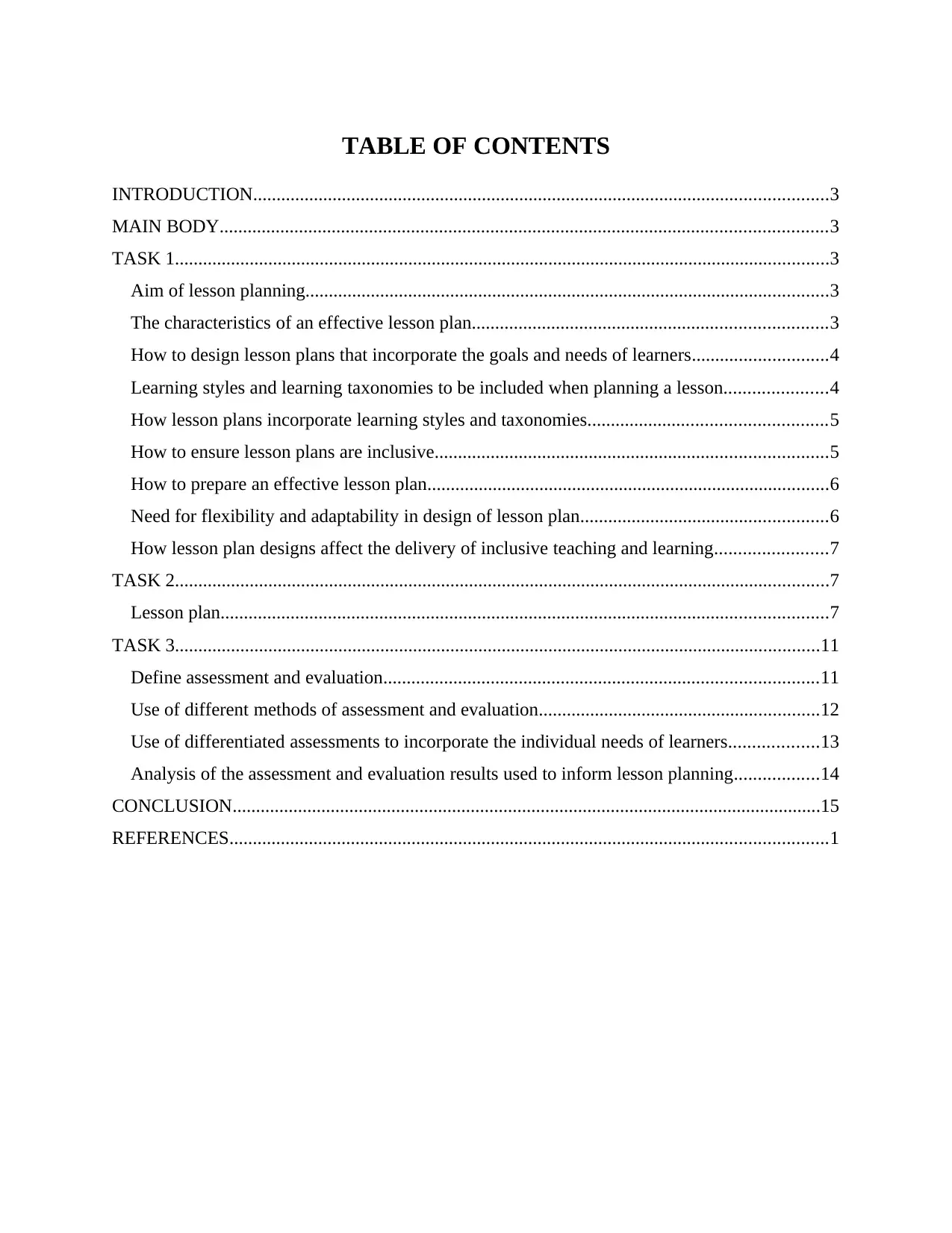
TABLE OF CONTENTS
INTRODUCTION...........................................................................................................................3
MAIN BODY..................................................................................................................................3
TASK 1............................................................................................................................................3
Aim of lesson planning................................................................................................................3
The characteristics of an effective lesson plan............................................................................3
How to design lesson plans that incorporate the goals and needs of learners.............................4
Learning styles and learning taxonomies to be included when planning a lesson......................4
How lesson plans incorporate learning styles and taxonomies...................................................5
How to ensure lesson plans are inclusive....................................................................................5
How to prepare an effective lesson plan......................................................................................6
Need for flexibility and adaptability in design of lesson plan.....................................................6
How lesson plan designs affect the delivery of inclusive teaching and learning........................7
TASK 2............................................................................................................................................7
Lesson plan..................................................................................................................................7
TASK 3..........................................................................................................................................11
Define assessment and evaluation.............................................................................................11
Use of different methods of assessment and evaluation............................................................12
Use of differentiated assessments to incorporate the individual needs of learners...................13
Analysis of the assessment and evaluation results used to inform lesson planning..................14
CONCLUSION..............................................................................................................................15
REFERENCES................................................................................................................................1
INTRODUCTION...........................................................................................................................3
MAIN BODY..................................................................................................................................3
TASK 1............................................................................................................................................3
Aim of lesson planning................................................................................................................3
The characteristics of an effective lesson plan............................................................................3
How to design lesson plans that incorporate the goals and needs of learners.............................4
Learning styles and learning taxonomies to be included when planning a lesson......................4
How lesson plans incorporate learning styles and taxonomies...................................................5
How to ensure lesson plans are inclusive....................................................................................5
How to prepare an effective lesson plan......................................................................................6
Need for flexibility and adaptability in design of lesson plan.....................................................6
How lesson plan designs affect the delivery of inclusive teaching and learning........................7
TASK 2............................................................................................................................................7
Lesson plan..................................................................................................................................7
TASK 3..........................................................................................................................................11
Define assessment and evaluation.............................................................................................11
Use of different methods of assessment and evaluation............................................................12
Use of differentiated assessments to incorporate the individual needs of learners...................13
Analysis of the assessment and evaluation results used to inform lesson planning..................14
CONCLUSION..............................................................................................................................15
REFERENCES................................................................................................................................1
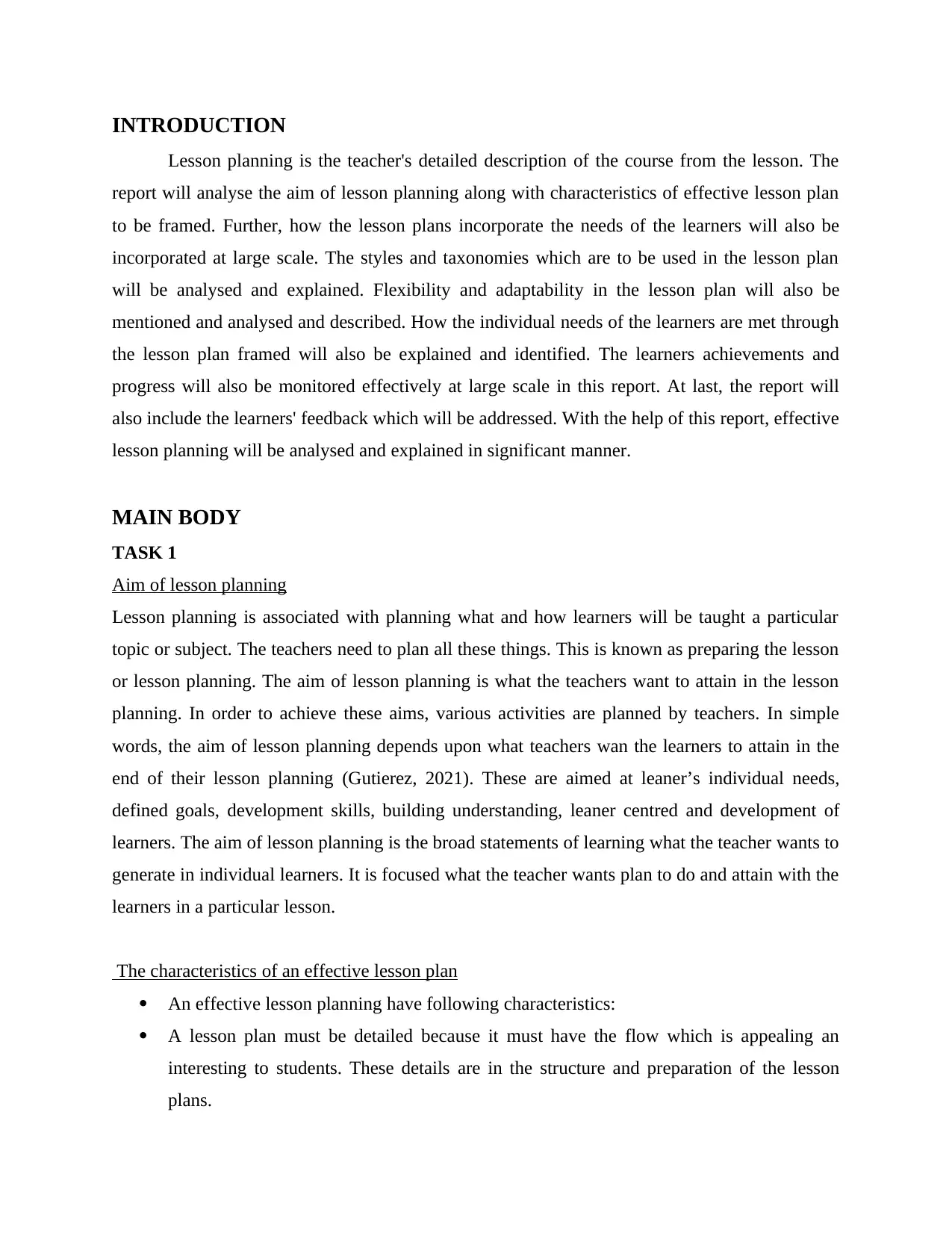
INTRODUCTION
Lesson planning is the teacher's detailed description of the course from the lesson. The
report will analyse the aim of lesson planning along with characteristics of effective lesson plan
to be framed. Further, how the lesson plans incorporate the needs of the learners will also be
incorporated at large scale. The styles and taxonomies which are to be used in the lesson plan
will be analysed and explained. Flexibility and adaptability in the lesson plan will also be
mentioned and analysed and described. How the individual needs of the learners are met through
the lesson plan framed will also be explained and identified. The learners achievements and
progress will also be monitored effectively at large scale in this report. At last, the report will
also include the learners' feedback which will be addressed. With the help of this report, effective
lesson planning will be analysed and explained in significant manner.
MAIN BODY
TASK 1
Aim of lesson planning
Lesson planning is associated with planning what and how learners will be taught a particular
topic or subject. The teachers need to plan all these things. This is known as preparing the lesson
or lesson planning. The aim of lesson planning is what the teachers want to attain in the lesson
planning. In order to achieve these aims, various activities are planned by teachers. In simple
words, the aim of lesson planning depends upon what teachers wan the learners to attain in the
end of their lesson planning (Gutierez, 2021). These are aimed at leaner’s individual needs,
defined goals, development skills, building understanding, leaner centred and development of
learners. The aim of lesson planning is the broad statements of learning what the teacher wants to
generate in individual learners. It is focused what the teacher wants plan to do and attain with the
learners in a particular lesson.
The characteristics of an effective lesson plan
An effective lesson planning have following characteristics:
A lesson plan must be detailed because it must have the flow which is appealing an
interesting to students. These details are in the structure and preparation of the lesson
plans.
Lesson planning is the teacher's detailed description of the course from the lesson. The
report will analyse the aim of lesson planning along with characteristics of effective lesson plan
to be framed. Further, how the lesson plans incorporate the needs of the learners will also be
incorporated at large scale. The styles and taxonomies which are to be used in the lesson plan
will be analysed and explained. Flexibility and adaptability in the lesson plan will also be
mentioned and analysed and described. How the individual needs of the learners are met through
the lesson plan framed will also be explained and identified. The learners achievements and
progress will also be monitored effectively at large scale in this report. At last, the report will
also include the learners' feedback which will be addressed. With the help of this report, effective
lesson planning will be analysed and explained in significant manner.
MAIN BODY
TASK 1
Aim of lesson planning
Lesson planning is associated with planning what and how learners will be taught a particular
topic or subject. The teachers need to plan all these things. This is known as preparing the lesson
or lesson planning. The aim of lesson planning is what the teachers want to attain in the lesson
planning. In order to achieve these aims, various activities are planned by teachers. In simple
words, the aim of lesson planning depends upon what teachers wan the learners to attain in the
end of their lesson planning (Gutierez, 2021). These are aimed at leaner’s individual needs,
defined goals, development skills, building understanding, leaner centred and development of
learners. The aim of lesson planning is the broad statements of learning what the teacher wants to
generate in individual learners. It is focused what the teacher wants plan to do and attain with the
learners in a particular lesson.
The characteristics of an effective lesson plan
An effective lesson planning have following characteristics:
A lesson plan must be detailed because it must have the flow which is appealing an
interesting to students. These details are in the structure and preparation of the lesson
plans.
⊘ This is a preview!⊘
Do you want full access?
Subscribe today to unlock all pages.

Trusted by 1+ million students worldwide
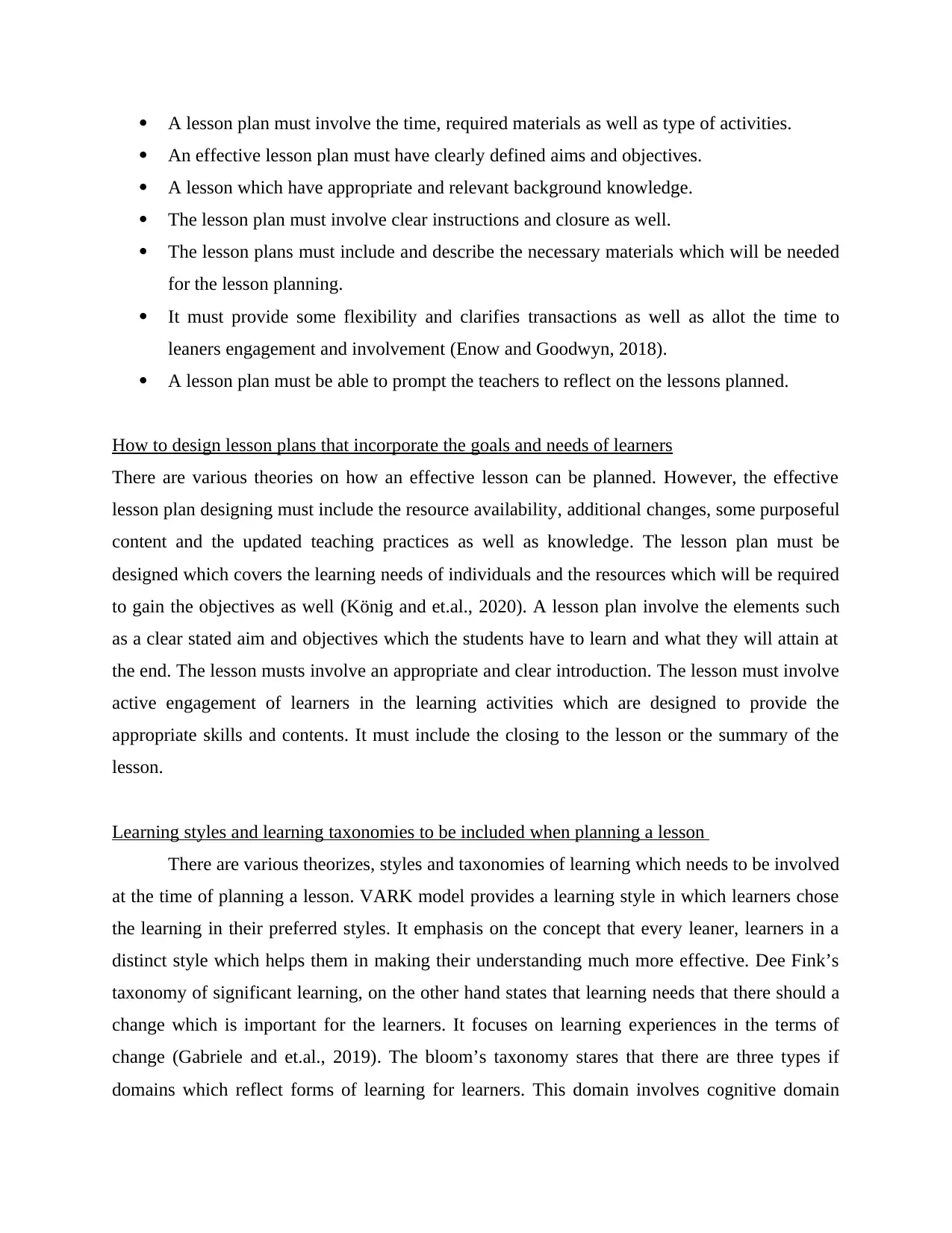
A lesson plan must involve the time, required materials as well as type of activities.
An effective lesson plan must have clearly defined aims and objectives.
A lesson which have appropriate and relevant background knowledge.
The lesson plan must involve clear instructions and closure as well.
The lesson plans must include and describe the necessary materials which will be needed
for the lesson planning.
It must provide some flexibility and clarifies transactions as well as allot the time to
leaners engagement and involvement (Enow and Goodwyn, 2018).
A lesson plan must be able to prompt the teachers to reflect on the lessons planned.
How to design lesson plans that incorporate the goals and needs of learners
There are various theories on how an effective lesson can be planned. However, the effective
lesson plan designing must include the resource availability, additional changes, some purposeful
content and the updated teaching practices as well as knowledge. The lesson plan must be
designed which covers the learning needs of individuals and the resources which will be required
to gain the objectives as well (König and et.al., 2020). A lesson plan involve the elements such
as a clear stated aim and objectives which the students have to learn and what they will attain at
the end. The lesson musts involve an appropriate and clear introduction. The lesson must involve
active engagement of learners in the learning activities which are designed to provide the
appropriate skills and contents. It must include the closing to the lesson or the summary of the
lesson.
Learning styles and learning taxonomies to be included when planning a lesson
There are various theorizes, styles and taxonomies of learning which needs to be involved
at the time of planning a lesson. VARK model provides a learning style in which learners chose
the learning in their preferred styles. It emphasis on the concept that every leaner, learners in a
distinct style which helps them in making their understanding much more effective. Dee Fink’s
taxonomy of significant learning, on the other hand states that learning needs that there should a
change which is important for the learners. It focuses on learning experiences in the terms of
change (Gabriele and et.al., 2019). The bloom’s taxonomy stares that there are three types if
domains which reflect forms of learning for learners. This domain involves cognitive domain
An effective lesson plan must have clearly defined aims and objectives.
A lesson which have appropriate and relevant background knowledge.
The lesson plan must involve clear instructions and closure as well.
The lesson plans must include and describe the necessary materials which will be needed
for the lesson planning.
It must provide some flexibility and clarifies transactions as well as allot the time to
leaners engagement and involvement (Enow and Goodwyn, 2018).
A lesson plan must be able to prompt the teachers to reflect on the lessons planned.
How to design lesson plans that incorporate the goals and needs of learners
There are various theories on how an effective lesson can be planned. However, the effective
lesson plan designing must include the resource availability, additional changes, some purposeful
content and the updated teaching practices as well as knowledge. The lesson plan must be
designed which covers the learning needs of individuals and the resources which will be required
to gain the objectives as well (König and et.al., 2020). A lesson plan involve the elements such
as a clear stated aim and objectives which the students have to learn and what they will attain at
the end. The lesson musts involve an appropriate and clear introduction. The lesson must involve
active engagement of learners in the learning activities which are designed to provide the
appropriate skills and contents. It must include the closing to the lesson or the summary of the
lesson.
Learning styles and learning taxonomies to be included when planning a lesson
There are various theorizes, styles and taxonomies of learning which needs to be involved
at the time of planning a lesson. VARK model provides a learning style in which learners chose
the learning in their preferred styles. It emphasis on the concept that every leaner, learners in a
distinct style which helps them in making their understanding much more effective. Dee Fink’s
taxonomy of significant learning, on the other hand states that learning needs that there should a
change which is important for the learners. It focuses on learning experiences in the terms of
change (Gabriele and et.al., 2019). The bloom’s taxonomy stares that there are three types if
domains which reflect forms of learning for learners. This domain involves cognitive domain
Paraphrase This Document
Need a fresh take? Get an instant paraphrase of this document with our AI Paraphraser
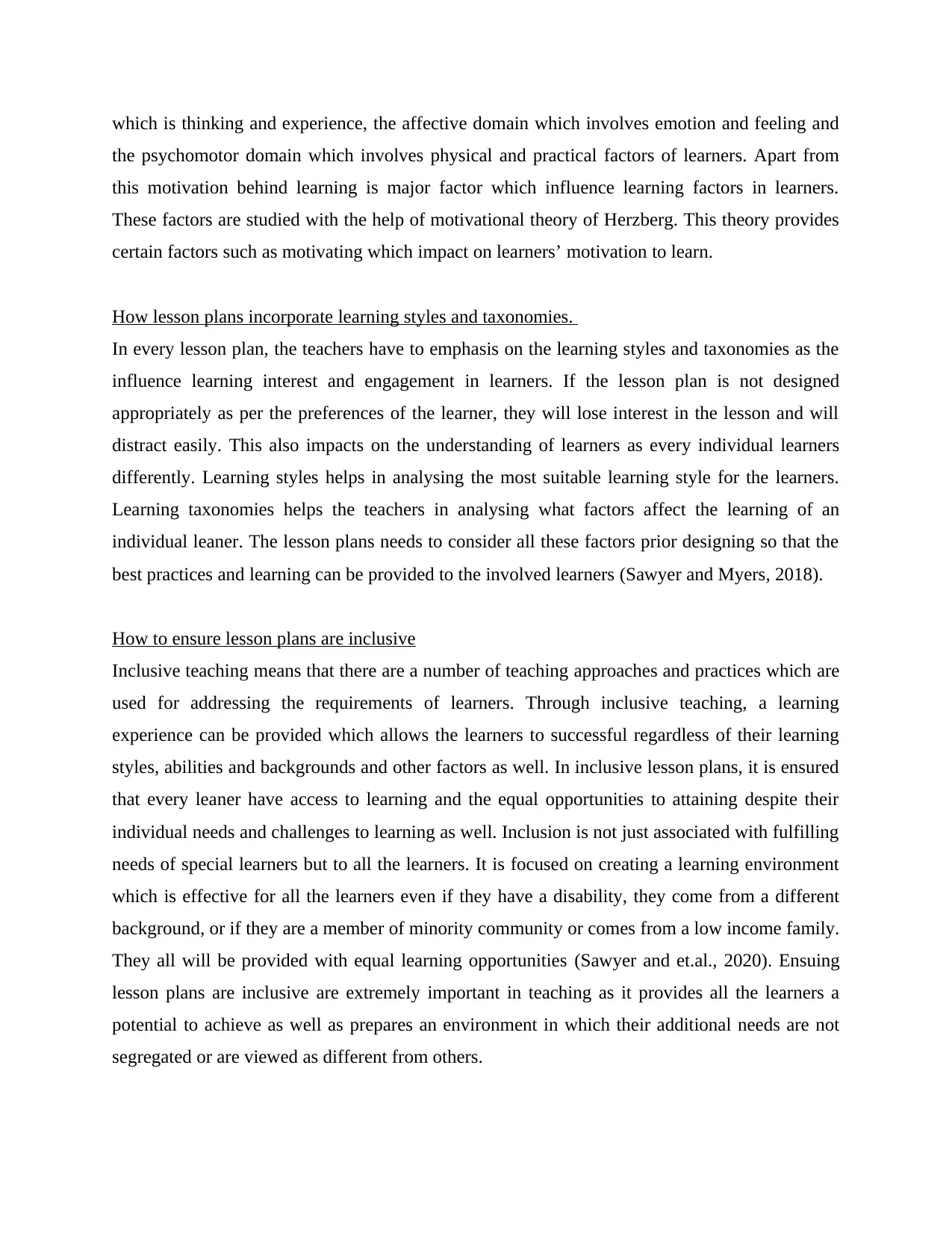
which is thinking and experience, the affective domain which involves emotion and feeling and
the psychomotor domain which involves physical and practical factors of learners. Apart from
this motivation behind learning is major factor which influence learning factors in learners.
These factors are studied with the help of motivational theory of Herzberg. This theory provides
certain factors such as motivating which impact on learners’ motivation to learn.
How lesson plans incorporate learning styles and taxonomies.
In every lesson plan, the teachers have to emphasis on the learning styles and taxonomies as the
influence learning interest and engagement in learners. If the lesson plan is not designed
appropriately as per the preferences of the learner, they will lose interest in the lesson and will
distract easily. This also impacts on the understanding of learners as every individual learners
differently. Learning styles helps in analysing the most suitable learning style for the learners.
Learning taxonomies helps the teachers in analysing what factors affect the learning of an
individual leaner. The lesson plans needs to consider all these factors prior designing so that the
best practices and learning can be provided to the involved learners (Sawyer and Myers, 2018).
How to ensure lesson plans are inclusive
Inclusive teaching means that there are a number of teaching approaches and practices which are
used for addressing the requirements of learners. Through inclusive teaching, a learning
experience can be provided which allows the learners to successful regardless of their learning
styles, abilities and backgrounds and other factors as well. In inclusive lesson plans, it is ensured
that every leaner have access to learning and the equal opportunities to attaining despite their
individual needs and challenges to learning as well. Inclusion is not just associated with fulfilling
needs of special learners but to all the learners. It is focused on creating a learning environment
which is effective for all the learners even if they have a disability, they come from a different
background, or if they are a member of minority community or comes from a low income family.
They all will be provided with equal learning opportunities (Sawyer and et.al., 2020). Ensuing
lesson plans are inclusive are extremely important in teaching as it provides all the learners a
potential to achieve as well as prepares an environment in which their additional needs are not
segregated or are viewed as different from others.
the psychomotor domain which involves physical and practical factors of learners. Apart from
this motivation behind learning is major factor which influence learning factors in learners.
These factors are studied with the help of motivational theory of Herzberg. This theory provides
certain factors such as motivating which impact on learners’ motivation to learn.
How lesson plans incorporate learning styles and taxonomies.
In every lesson plan, the teachers have to emphasis on the learning styles and taxonomies as the
influence learning interest and engagement in learners. If the lesson plan is not designed
appropriately as per the preferences of the learner, they will lose interest in the lesson and will
distract easily. This also impacts on the understanding of learners as every individual learners
differently. Learning styles helps in analysing the most suitable learning style for the learners.
Learning taxonomies helps the teachers in analysing what factors affect the learning of an
individual leaner. The lesson plans needs to consider all these factors prior designing so that the
best practices and learning can be provided to the involved learners (Sawyer and Myers, 2018).
How to ensure lesson plans are inclusive
Inclusive teaching means that there are a number of teaching approaches and practices which are
used for addressing the requirements of learners. Through inclusive teaching, a learning
experience can be provided which allows the learners to successful regardless of their learning
styles, abilities and backgrounds and other factors as well. In inclusive lesson plans, it is ensured
that every leaner have access to learning and the equal opportunities to attaining despite their
individual needs and challenges to learning as well. Inclusion is not just associated with fulfilling
needs of special learners but to all the learners. It is focused on creating a learning environment
which is effective for all the learners even if they have a disability, they come from a different
background, or if they are a member of minority community or comes from a low income family.
They all will be provided with equal learning opportunities (Sawyer and et.al., 2020). Ensuing
lesson plans are inclusive are extremely important in teaching as it provides all the learners a
potential to achieve as well as prepares an environment in which their additional needs are not
segregated or are viewed as different from others.
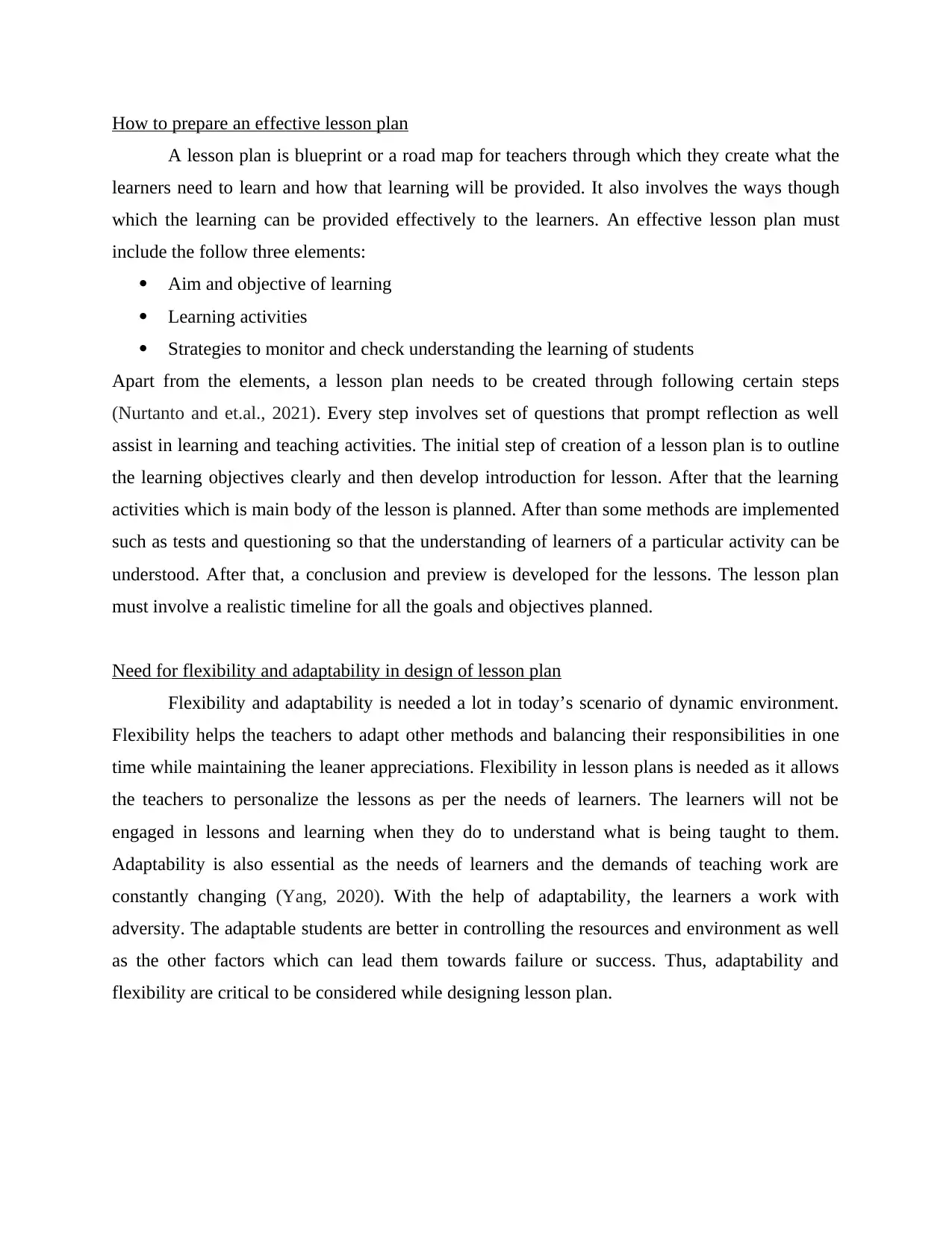
How to prepare an effective lesson plan
A lesson plan is blueprint or a road map for teachers through which they create what the
learners need to learn and how that learning will be provided. It also involves the ways though
which the learning can be provided effectively to the learners. An effective lesson plan must
include the follow three elements:
Aim and objective of learning
Learning activities
Strategies to monitor and check understanding the learning of students
Apart from the elements, a lesson plan needs to be created through following certain steps
(Nurtanto and et.al., 2021). Every step involves set of questions that prompt reflection as well
assist in learning and teaching activities. The initial step of creation of a lesson plan is to outline
the learning objectives clearly and then develop introduction for lesson. After that the learning
activities which is main body of the lesson is planned. After than some methods are implemented
such as tests and questioning so that the understanding of learners of a particular activity can be
understood. After that, a conclusion and preview is developed for the lessons. The lesson plan
must involve a realistic timeline for all the goals and objectives planned.
Need for flexibility and adaptability in design of lesson plan
Flexibility and adaptability is needed a lot in today’s scenario of dynamic environment.
Flexibility helps the teachers to adapt other methods and balancing their responsibilities in one
time while maintaining the leaner appreciations. Flexibility in lesson plans is needed as it allows
the teachers to personalize the lessons as per the needs of learners. The learners will not be
engaged in lessons and learning when they do to understand what is being taught to them.
Adaptability is also essential as the needs of learners and the demands of teaching work are
constantly changing (Yang, 2020). With the help of adaptability, the learners a work with
adversity. The adaptable students are better in controlling the resources and environment as well
as the other factors which can lead them towards failure or success. Thus, adaptability and
flexibility are critical to be considered while designing lesson plan.
A lesson plan is blueprint or a road map for teachers through which they create what the
learners need to learn and how that learning will be provided. It also involves the ways though
which the learning can be provided effectively to the learners. An effective lesson plan must
include the follow three elements:
Aim and objective of learning
Learning activities
Strategies to monitor and check understanding the learning of students
Apart from the elements, a lesson plan needs to be created through following certain steps
(Nurtanto and et.al., 2021). Every step involves set of questions that prompt reflection as well
assist in learning and teaching activities. The initial step of creation of a lesson plan is to outline
the learning objectives clearly and then develop introduction for lesson. After that the learning
activities which is main body of the lesson is planned. After than some methods are implemented
such as tests and questioning so that the understanding of learners of a particular activity can be
understood. After that, a conclusion and preview is developed for the lessons. The lesson plan
must involve a realistic timeline for all the goals and objectives planned.
Need for flexibility and adaptability in design of lesson plan
Flexibility and adaptability is needed a lot in today’s scenario of dynamic environment.
Flexibility helps the teachers to adapt other methods and balancing their responsibilities in one
time while maintaining the leaner appreciations. Flexibility in lesson plans is needed as it allows
the teachers to personalize the lessons as per the needs of learners. The learners will not be
engaged in lessons and learning when they do to understand what is being taught to them.
Adaptability is also essential as the needs of learners and the demands of teaching work are
constantly changing (Yang, 2020). With the help of adaptability, the learners a work with
adversity. The adaptable students are better in controlling the resources and environment as well
as the other factors which can lead them towards failure or success. Thus, adaptability and
flexibility are critical to be considered while designing lesson plan.
⊘ This is a preview!⊘
Do you want full access?
Subscribe today to unlock all pages.

Trusted by 1+ million students worldwide
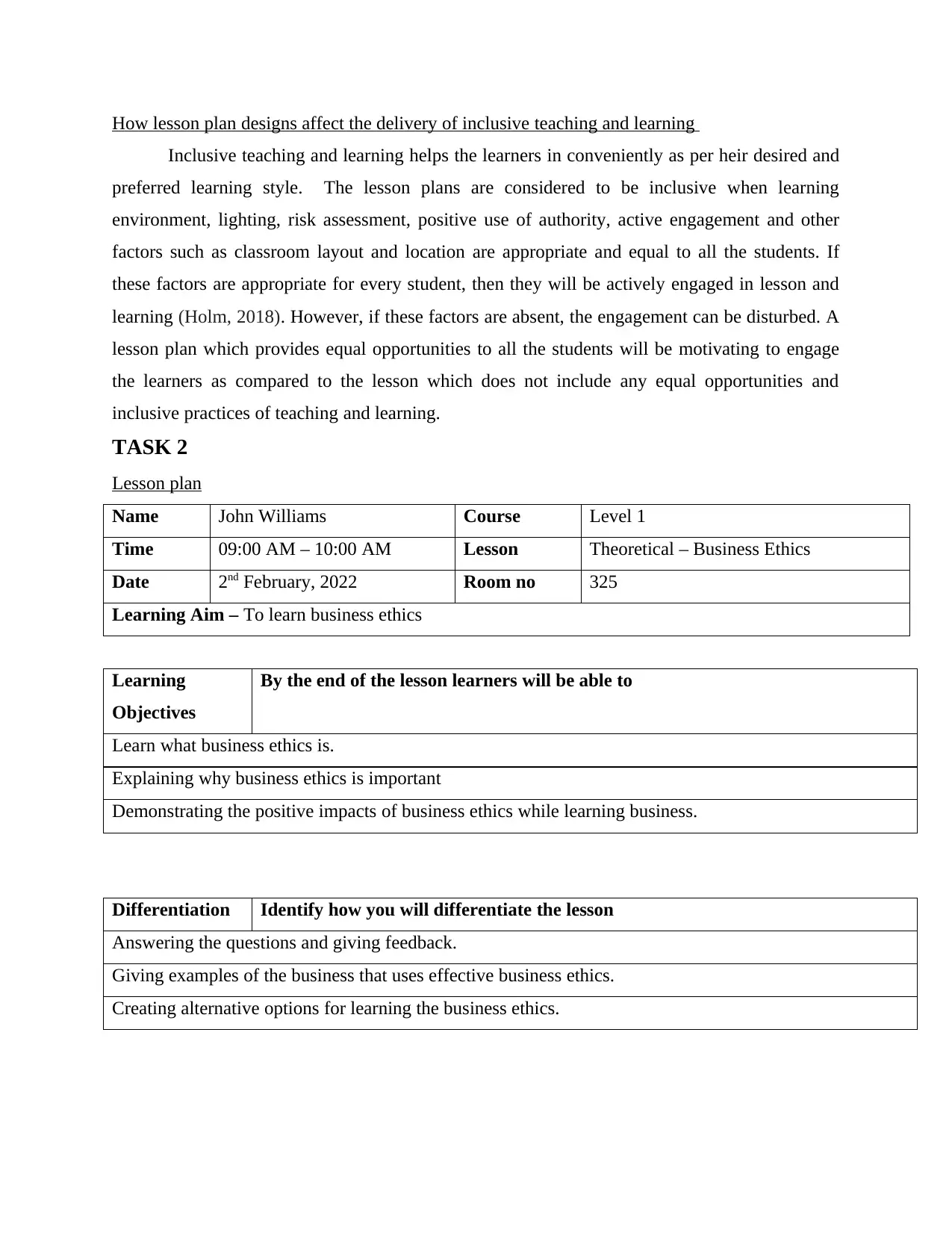
How lesson plan designs affect the delivery of inclusive teaching and learning
Inclusive teaching and learning helps the learners in conveniently as per heir desired and
preferred learning style. The lesson plans are considered to be inclusive when learning
environment, lighting, risk assessment, positive use of authority, active engagement and other
factors such as classroom layout and location are appropriate and equal to all the students. If
these factors are appropriate for every student, then they will be actively engaged in lesson and
learning (Holm, 2018). However, if these factors are absent, the engagement can be disturbed. A
lesson plan which provides equal opportunities to all the students will be motivating to engage
the learners as compared to the lesson which does not include any equal opportunities and
inclusive practices of teaching and learning.
TASK 2
Lesson plan
Name John Williams Course Level 1
Time 09:00 AM – 10:00 AM Lesson Theoretical – Business Ethics
Date 2nd February, 2022 Room no 325
Learning Aim – To learn business ethics
Learning
Objectives
By the end of the lesson learners will be able to
Learn what business ethics is.
Explaining why business ethics is important
Demonstrating the positive impacts of business ethics while learning business.
Differentiation Identify how you will differentiate the lesson
Answering the questions and giving feedback.
Giving examples of the business that uses effective business ethics.
Creating alternative options for learning the business ethics.
Inclusive teaching and learning helps the learners in conveniently as per heir desired and
preferred learning style. The lesson plans are considered to be inclusive when learning
environment, lighting, risk assessment, positive use of authority, active engagement and other
factors such as classroom layout and location are appropriate and equal to all the students. If
these factors are appropriate for every student, then they will be actively engaged in lesson and
learning (Holm, 2018). However, if these factors are absent, the engagement can be disturbed. A
lesson plan which provides equal opportunities to all the students will be motivating to engage
the learners as compared to the lesson which does not include any equal opportunities and
inclusive practices of teaching and learning.
TASK 2
Lesson plan
Name John Williams Course Level 1
Time 09:00 AM – 10:00 AM Lesson Theoretical – Business Ethics
Date 2nd February, 2022 Room no 325
Learning Aim – To learn business ethics
Learning
Objectives
By the end of the lesson learners will be able to
Learn what business ethics is.
Explaining why business ethics is important
Demonstrating the positive impacts of business ethics while learning business.
Differentiation Identify how you will differentiate the lesson
Answering the questions and giving feedback.
Giving examples of the business that uses effective business ethics.
Creating alternative options for learning the business ethics.
Paraphrase This Document
Need a fresh take? Get an instant paraphrase of this document with our AI Paraphraser
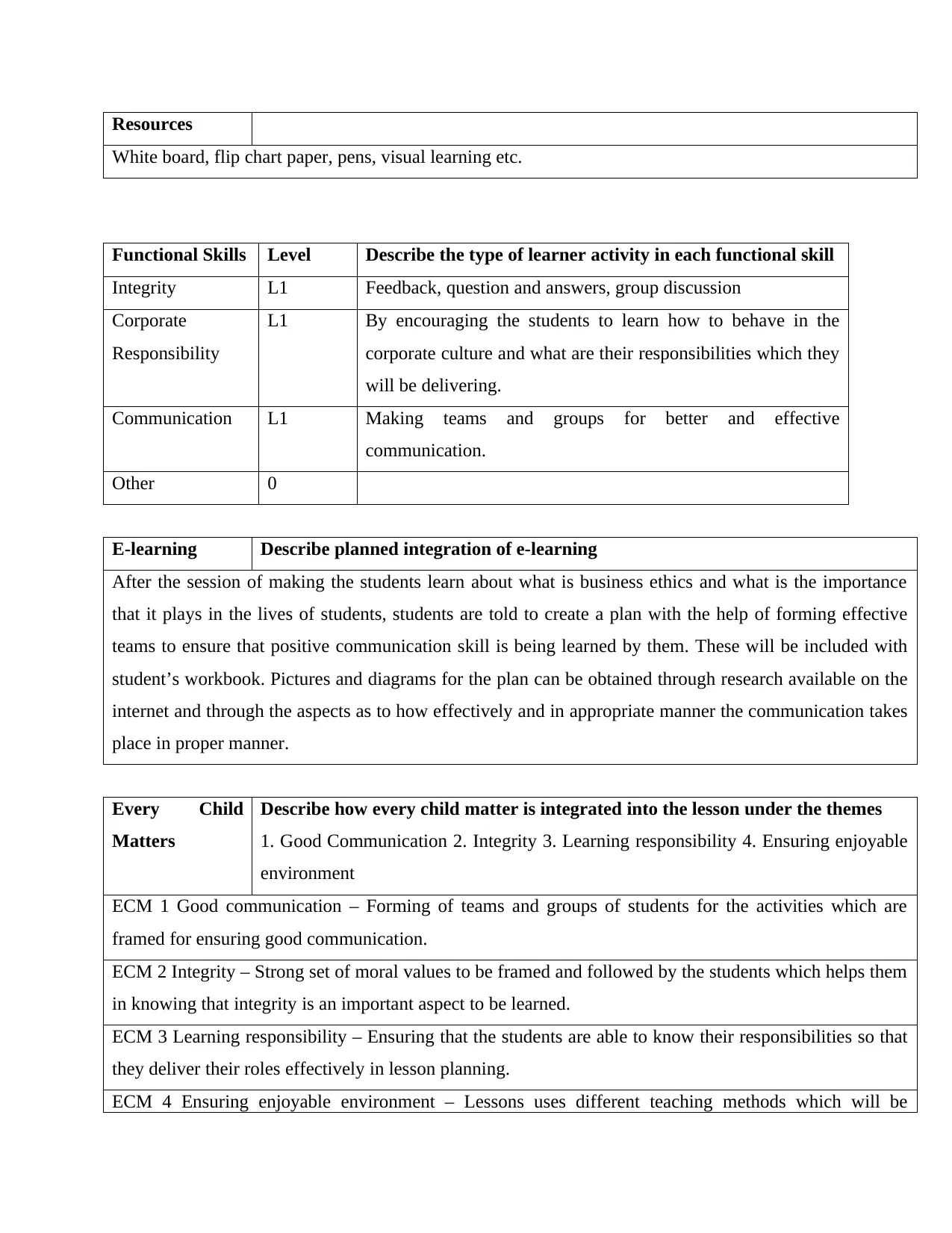
Resources
White board, flip chart paper, pens, visual learning etc.
Functional Skills Level Describe the type of learner activity in each functional skill
Integrity L1 Feedback, question and answers, group discussion
Corporate
Responsibility
L1 By encouraging the students to learn how to behave in the
corporate culture and what are their responsibilities which they
will be delivering.
Communication L1 Making teams and groups for better and effective
communication.
Other 0
E-learning Describe planned integration of e-learning
After the session of making the students learn about what is business ethics and what is the importance
that it plays in the lives of students, students are told to create a plan with the help of forming effective
teams to ensure that positive communication skill is being learned by them. These will be included with
student’s workbook. Pictures and diagrams for the plan can be obtained through research available on the
internet and through the aspects as to how effectively and in appropriate manner the communication takes
place in proper manner.
Every Child
Matters
Describe how every child matter is integrated into the lesson under the themes
1. Good Communication 2. Integrity 3. Learning responsibility 4. Ensuring enjoyable
environment
ECM 1 Good communication – Forming of teams and groups of students for the activities which are
framed for ensuring good communication.
ECM 2 Integrity – Strong set of moral values to be framed and followed by the students which helps them
in knowing that integrity is an important aspect to be learned.
ECM 3 Learning responsibility – Ensuring that the students are able to know their responsibilities so that
they deliver their roles effectively in lesson planning.
ECM 4 Ensuring enjoyable environment – Lessons uses different teaching methods which will be
White board, flip chart paper, pens, visual learning etc.
Functional Skills Level Describe the type of learner activity in each functional skill
Integrity L1 Feedback, question and answers, group discussion
Corporate
Responsibility
L1 By encouraging the students to learn how to behave in the
corporate culture and what are their responsibilities which they
will be delivering.
Communication L1 Making teams and groups for better and effective
communication.
Other 0
E-learning Describe planned integration of e-learning
After the session of making the students learn about what is business ethics and what is the importance
that it plays in the lives of students, students are told to create a plan with the help of forming effective
teams to ensure that positive communication skill is being learned by them. These will be included with
student’s workbook. Pictures and diagrams for the plan can be obtained through research available on the
internet and through the aspects as to how effectively and in appropriate manner the communication takes
place in proper manner.
Every Child
Matters
Describe how every child matter is integrated into the lesson under the themes
1. Good Communication 2. Integrity 3. Learning responsibility 4. Ensuring enjoyable
environment
ECM 1 Good communication – Forming of teams and groups of students for the activities which are
framed for ensuring good communication.
ECM 2 Integrity – Strong set of moral values to be framed and followed by the students which helps them
in knowing that integrity is an important aspect to be learned.
ECM 3 Learning responsibility – Ensuring that the students are able to know their responsibilities so that
they deliver their roles effectively in lesson planning.
ECM 4 Ensuring enjoyable environment – Lessons uses different teaching methods which will be
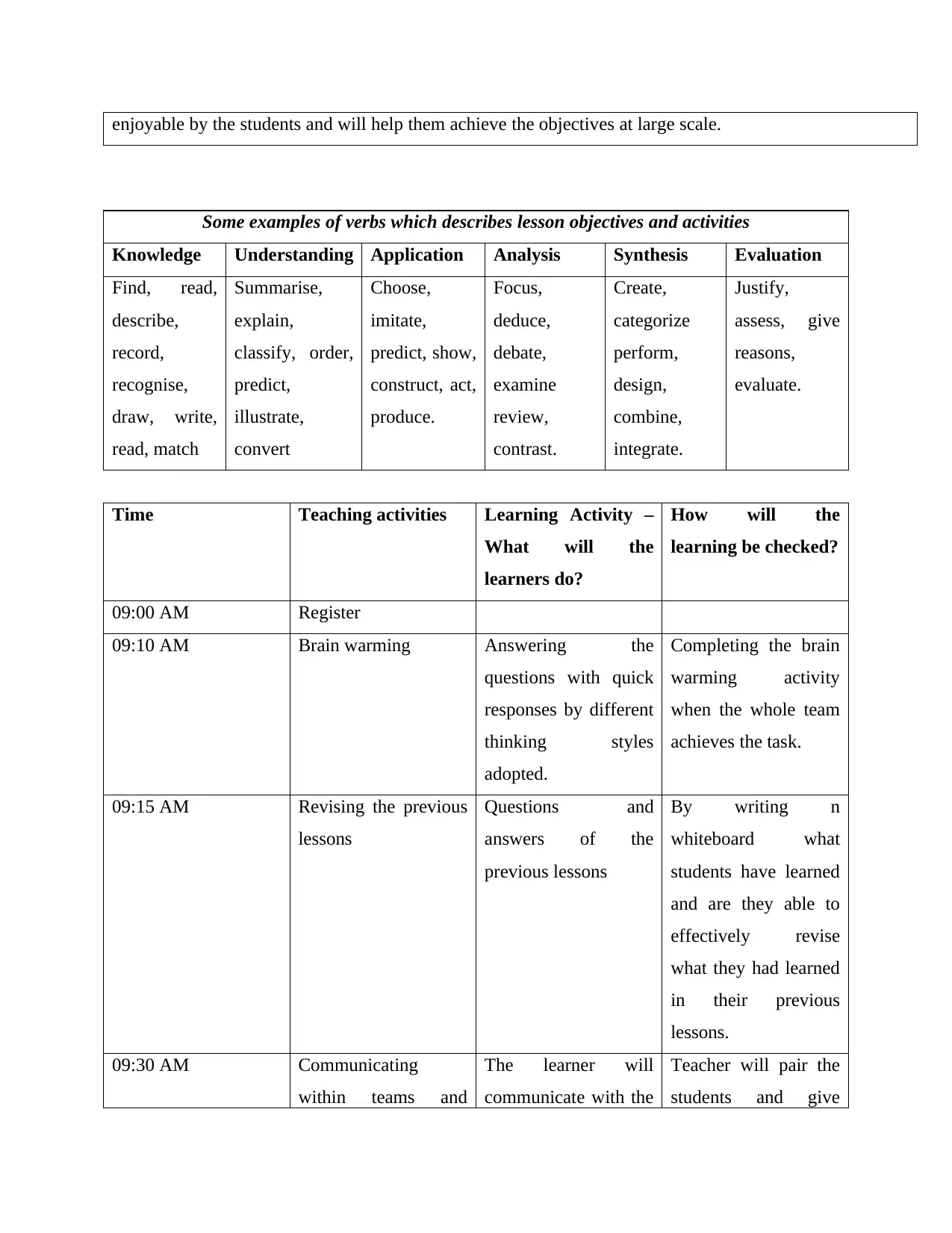
enjoyable by the students and will help them achieve the objectives at large scale.
Some examples of verbs which describes lesson objectives and activities
Knowledge Understanding Application Analysis Synthesis Evaluation
Find, read,
describe,
record,
recognise,
draw, write,
read, match
Summarise,
explain,
classify, order,
predict,
illustrate,
convert
Choose,
imitate,
predict, show,
construct, act,
produce.
Focus,
deduce,
debate,
examine
review,
contrast.
Create,
categorize
perform,
design,
combine,
integrate.
Justify,
assess, give
reasons,
evaluate.
Time Teaching activities Learning Activity –
What will the
learners do?
How will the
learning be checked?
09:00 AM Register
09:10 AM Brain warming Answering the
questions with quick
responses by different
thinking styles
adopted.
Completing the brain
warming activity
when the whole team
achieves the task.
09:15 AM Revising the previous
lessons
Questions and
answers of the
previous lessons
By writing n
whiteboard what
students have learned
and are they able to
effectively revise
what they had learned
in their previous
lessons.
09:30 AM Communicating
within teams and
The learner will
communicate with the
Teacher will pair the
students and give
Some examples of verbs which describes lesson objectives and activities
Knowledge Understanding Application Analysis Synthesis Evaluation
Find, read,
describe,
record,
recognise,
draw, write,
read, match
Summarise,
explain,
classify, order,
predict,
illustrate,
convert
Choose,
imitate,
predict, show,
construct, act,
produce.
Focus,
deduce,
debate,
examine
review,
contrast.
Create,
categorize
perform,
design,
combine,
integrate.
Justify,
assess, give
reasons,
evaluate.
Time Teaching activities Learning Activity –
What will the
learners do?
How will the
learning be checked?
09:00 AM Register
09:10 AM Brain warming Answering the
questions with quick
responses by different
thinking styles
adopted.
Completing the brain
warming activity
when the whole team
achieves the task.
09:15 AM Revising the previous
lessons
Questions and
answers of the
previous lessons
By writing n
whiteboard what
students have learned
and are they able to
effectively revise
what they had learned
in their previous
lessons.
09:30 AM Communicating
within teams and
The learner will
communicate with the
Teacher will pair the
students and give
⊘ This is a preview!⊘
Do you want full access?
Subscribe today to unlock all pages.

Trusted by 1+ million students worldwide
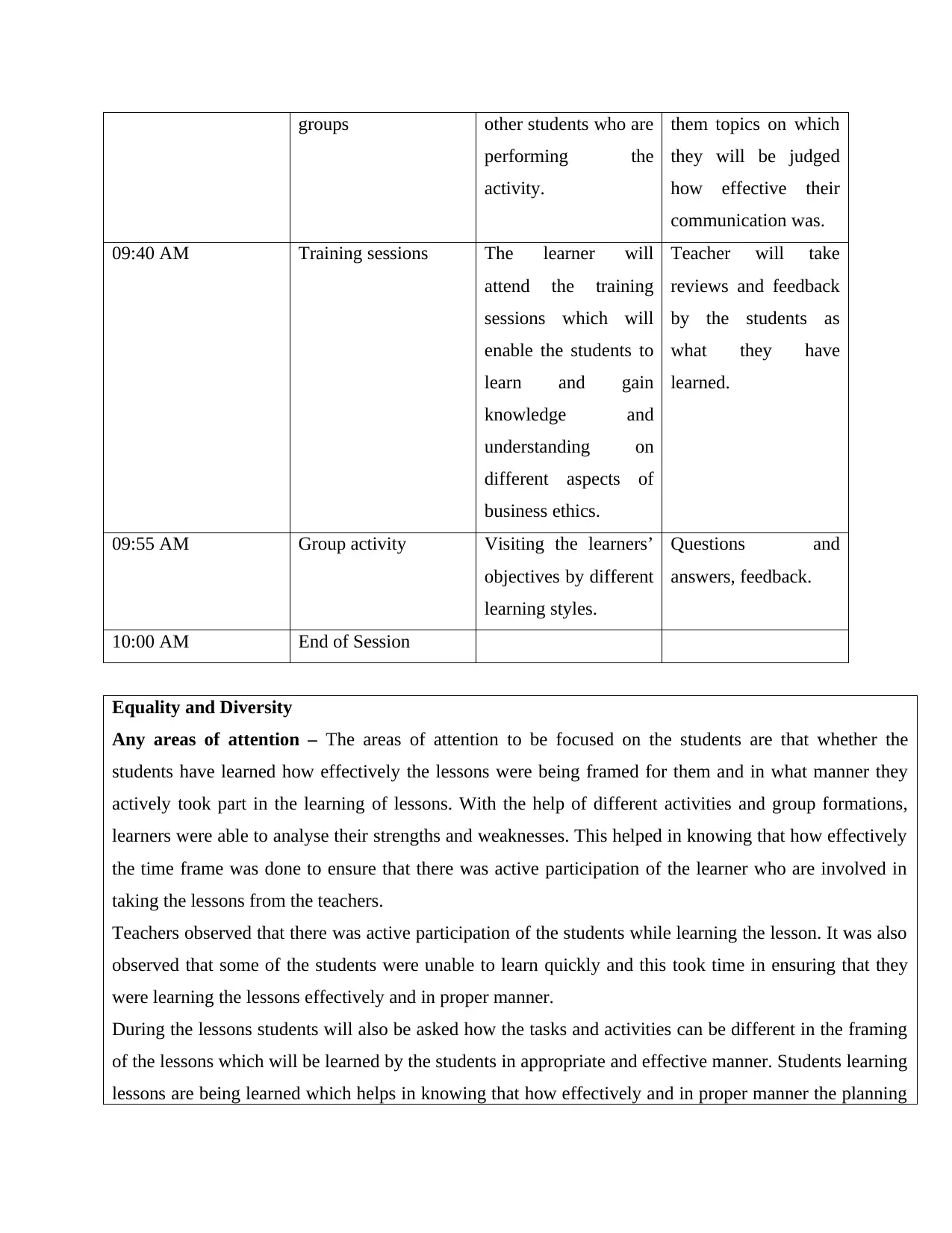
groups other students who are
performing the
activity.
them topics on which
they will be judged
how effective their
communication was.
09:40 AM Training sessions The learner will
attend the training
sessions which will
enable the students to
learn and gain
knowledge and
understanding on
different aspects of
business ethics.
Teacher will take
reviews and feedback
by the students as
what they have
learned.
09:55 AM Group activity Visiting the learners’
objectives by different
learning styles.
Questions and
answers, feedback.
10:00 AM End of Session
Equality and Diversity
Any areas of attention – The areas of attention to be focused on the students are that whether the
students have learned how effectively the lessons were being framed for them and in what manner they
actively took part in the learning of lessons. With the help of different activities and group formations,
learners were able to analyse their strengths and weaknesses. This helped in knowing that how effectively
the time frame was done to ensure that there was active participation of the learner who are involved in
taking the lessons from the teachers.
Teachers observed that there was active participation of the students while learning the lesson. It was also
observed that some of the students were unable to learn quickly and this took time in ensuring that they
were learning the lessons effectively and in proper manner.
During the lessons students will also be asked how the tasks and activities can be different in the framing
of the lessons which will be learned by the students in appropriate and effective manner. Students learning
lessons are being learned which helps in knowing that how effectively and in proper manner the planning
performing the
activity.
them topics on which
they will be judged
how effective their
communication was.
09:40 AM Training sessions The learner will
attend the training
sessions which will
enable the students to
learn and gain
knowledge and
understanding on
different aspects of
business ethics.
Teacher will take
reviews and feedback
by the students as
what they have
learned.
09:55 AM Group activity Visiting the learners’
objectives by different
learning styles.
Questions and
answers, feedback.
10:00 AM End of Session
Equality and Diversity
Any areas of attention – The areas of attention to be focused on the students are that whether the
students have learned how effectively the lessons were being framed for them and in what manner they
actively took part in the learning of lessons. With the help of different activities and group formations,
learners were able to analyse their strengths and weaknesses. This helped in knowing that how effectively
the time frame was done to ensure that there was active participation of the learner who are involved in
taking the lessons from the teachers.
Teachers observed that there was active participation of the students while learning the lesson. It was also
observed that some of the students were unable to learn quickly and this took time in ensuring that they
were learning the lessons effectively and in proper manner.
During the lessons students will also be asked how the tasks and activities can be different in the framing
of the lessons which will be learned by the students in appropriate and effective manner. Students learning
lessons are being learned which helps in knowing that how effectively and in proper manner the planning
Paraphrase This Document
Need a fresh take? Get an instant paraphrase of this document with our AI Paraphraser
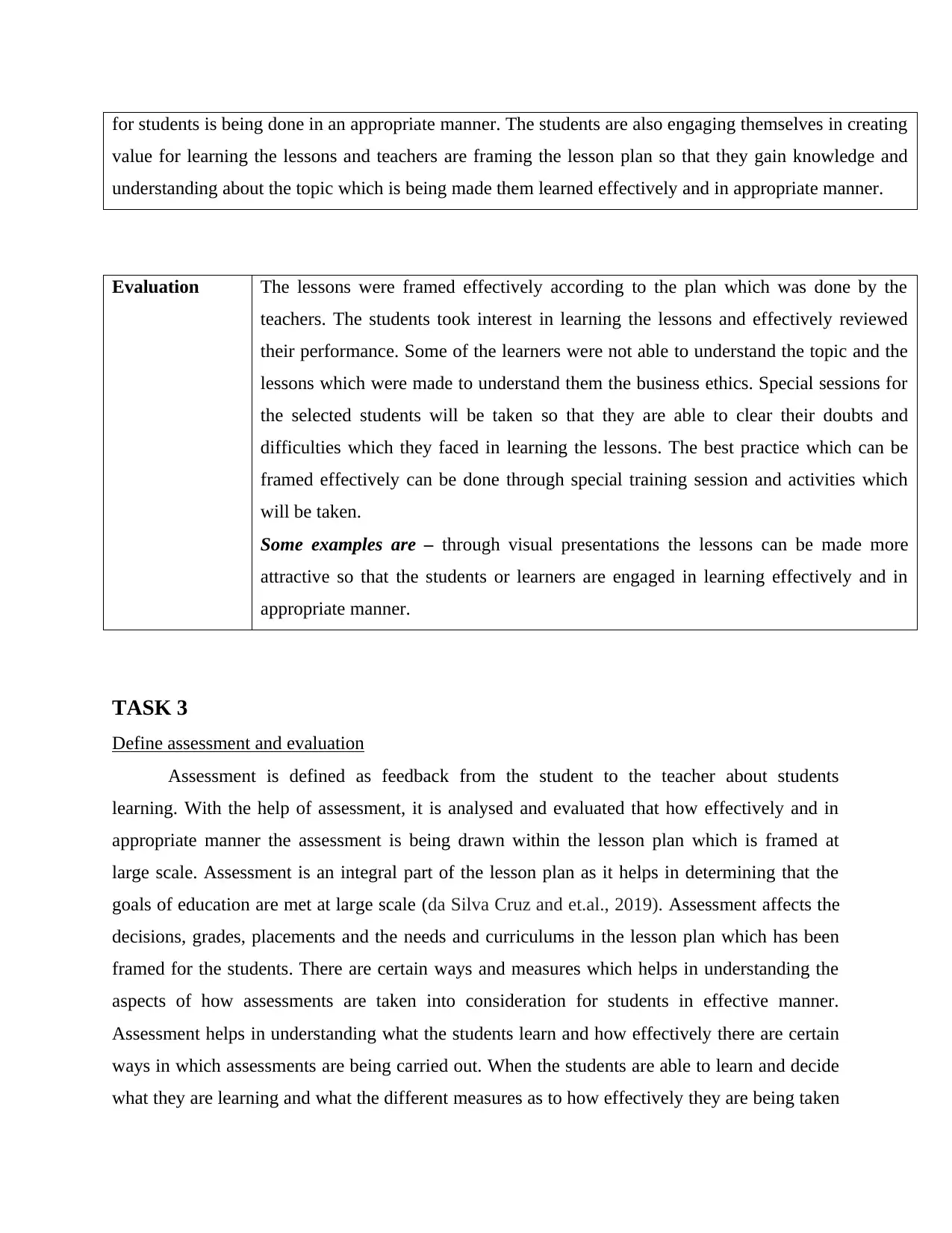
for students is being done in an appropriate manner. The students are also engaging themselves in creating
value for learning the lessons and teachers are framing the lesson plan so that they gain knowledge and
understanding about the topic which is being made them learned effectively and in appropriate manner.
Evaluation The lessons were framed effectively according to the plan which was done by the
teachers. The students took interest in learning the lessons and effectively reviewed
their performance. Some of the learners were not able to understand the topic and the
lessons which were made to understand them the business ethics. Special sessions for
the selected students will be taken so that they are able to clear their doubts and
difficulties which they faced in learning the lessons. The best practice which can be
framed effectively can be done through special training session and activities which
will be taken.
Some examples are – through visual presentations the lessons can be made more
attractive so that the students or learners are engaged in learning effectively and in
appropriate manner.
TASK 3
Define assessment and evaluation
Assessment is defined as feedback from the student to the teacher about students
learning. With the help of assessment, it is analysed and evaluated that how effectively and in
appropriate manner the assessment is being drawn within the lesson plan which is framed at
large scale. Assessment is an integral part of the lesson plan as it helps in determining that the
goals of education are met at large scale (da Silva Cruz and et.al., 2019). Assessment affects the
decisions, grades, placements and the needs and curriculums in the lesson plan which has been
framed for the students. There are certain ways and measures which helps in understanding the
aspects of how assessments are taken into consideration for students in effective manner.
Assessment helps in understanding what the students learn and how effectively there are certain
ways in which assessments are being carried out. When the students are able to learn and decide
what they are learning and what the different measures as to how effectively they are being taken
value for learning the lessons and teachers are framing the lesson plan so that they gain knowledge and
understanding about the topic which is being made them learned effectively and in appropriate manner.
Evaluation The lessons were framed effectively according to the plan which was done by the
teachers. The students took interest in learning the lessons and effectively reviewed
their performance. Some of the learners were not able to understand the topic and the
lessons which were made to understand them the business ethics. Special sessions for
the selected students will be taken so that they are able to clear their doubts and
difficulties which they faced in learning the lessons. The best practice which can be
framed effectively can be done through special training session and activities which
will be taken.
Some examples are – through visual presentations the lessons can be made more
attractive so that the students or learners are engaged in learning effectively and in
appropriate manner.
TASK 3
Define assessment and evaluation
Assessment is defined as feedback from the student to the teacher about students
learning. With the help of assessment, it is analysed and evaluated that how effectively and in
appropriate manner the assessment is being drawn within the lesson plan which is framed at
large scale. Assessment is an integral part of the lesson plan as it helps in determining that the
goals of education are met at large scale (da Silva Cruz and et.al., 2019). Assessment affects the
decisions, grades, placements and the needs and curriculums in the lesson plan which has been
framed for the students. There are certain ways and measures which helps in understanding the
aspects of how assessments are taken into consideration for students in effective manner.
Assessment helps in understanding what the students learn and how effectively there are certain
ways in which assessments are being carried out. When the students are able to learn and decide
what they are learning and what the different measures as to how effectively they are being taken
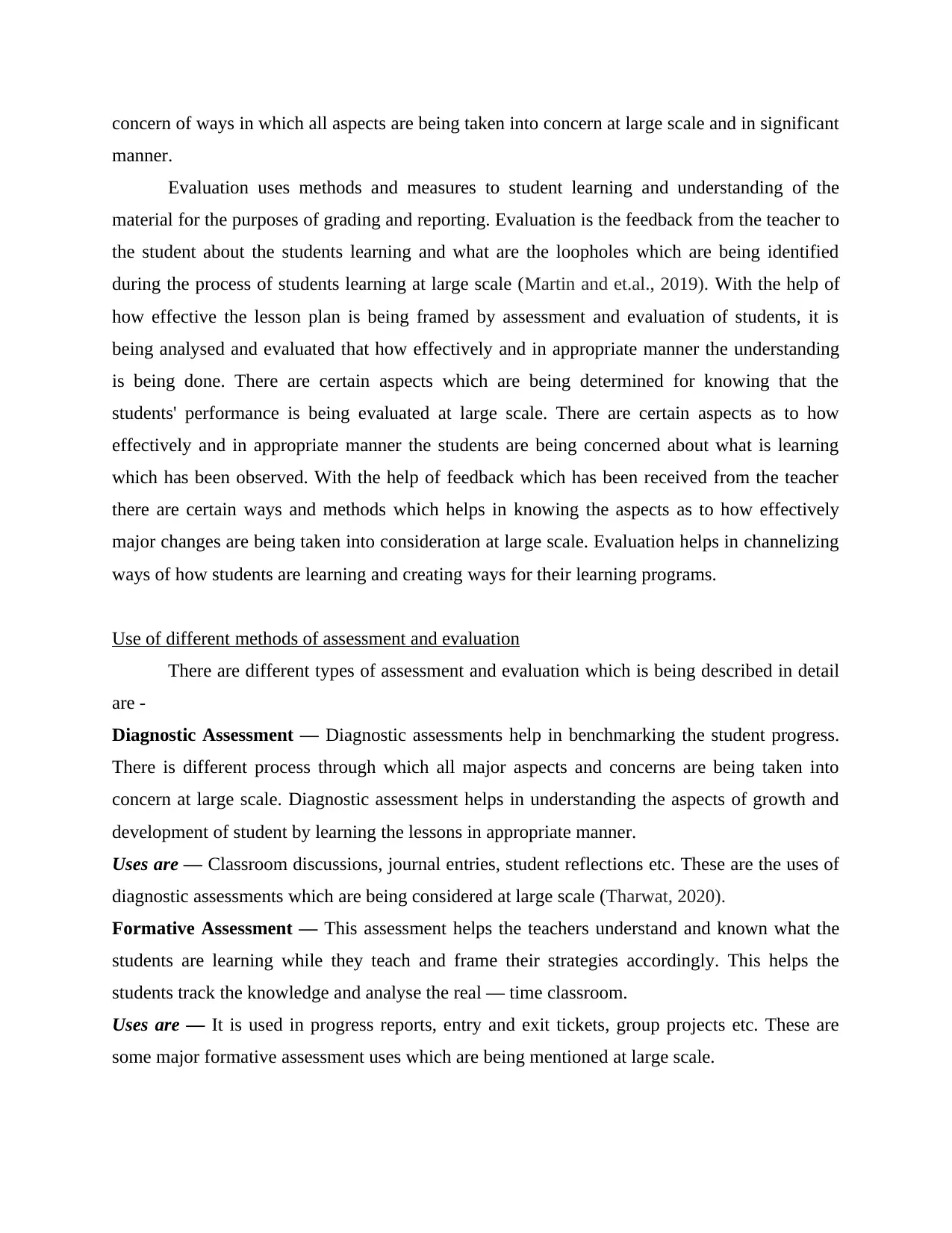
concern of ways in which all aspects are being taken into concern at large scale and in significant
manner.
Evaluation uses methods and measures to student learning and understanding of the
material for the purposes of grading and reporting. Evaluation is the feedback from the teacher to
the student about the students learning and what are the loopholes which are being identified
during the process of students learning at large scale (Martin and et.al., 2019). With the help of
how effective the lesson plan is being framed by assessment and evaluation of students, it is
being analysed and evaluated that how effectively and in appropriate manner the understanding
is being done. There are certain aspects which are being determined for knowing that the
students' performance is being evaluated at large scale. There are certain aspects as to how
effectively and in appropriate manner the students are being concerned about what is learning
which has been observed. With the help of feedback which has been received from the teacher
there are certain ways and methods which helps in knowing the aspects as to how effectively
major changes are being taken into consideration at large scale. Evaluation helps in channelizing
ways of how students are learning and creating ways for their learning programs.
Use of different methods of assessment and evaluation
There are different types of assessment and evaluation which is being described in detail
are -
Diagnostic Assessment — Diagnostic assessments help in benchmarking the student progress.
There is different process through which all major aspects and concerns are being taken into
concern at large scale. Diagnostic assessment helps in understanding the aspects of growth and
development of student by learning the lessons in appropriate manner.
Uses are — Classroom discussions, journal entries, student reflections etc. These are the uses of
diagnostic assessments which are being considered at large scale (Tharwat, 2020).
Formative Assessment — This assessment helps the teachers understand and known what the
students are learning while they teach and frame their strategies accordingly. This helps the
students track the knowledge and analyse the real — time classroom.
Uses are — It is used in progress reports, entry and exit tickets, group projects etc. These are
some major formative assessment uses which are being mentioned at large scale.
manner.
Evaluation uses methods and measures to student learning and understanding of the
material for the purposes of grading and reporting. Evaluation is the feedback from the teacher to
the student about the students learning and what are the loopholes which are being identified
during the process of students learning at large scale (Martin and et.al., 2019). With the help of
how effective the lesson plan is being framed by assessment and evaluation of students, it is
being analysed and evaluated that how effectively and in appropriate manner the understanding
is being done. There are certain aspects which are being determined for knowing that the
students' performance is being evaluated at large scale. There are certain aspects as to how
effectively and in appropriate manner the students are being concerned about what is learning
which has been observed. With the help of feedback which has been received from the teacher
there are certain ways and methods which helps in knowing the aspects as to how effectively
major changes are being taken into consideration at large scale. Evaluation helps in channelizing
ways of how students are learning and creating ways for their learning programs.
Use of different methods of assessment and evaluation
There are different types of assessment and evaluation which is being described in detail
are -
Diagnostic Assessment — Diagnostic assessments help in benchmarking the student progress.
There is different process through which all major aspects and concerns are being taken into
concern at large scale. Diagnostic assessment helps in understanding the aspects of growth and
development of student by learning the lessons in appropriate manner.
Uses are — Classroom discussions, journal entries, student reflections etc. These are the uses of
diagnostic assessments which are being considered at large scale (Tharwat, 2020).
Formative Assessment — This assessment helps the teachers understand and known what the
students are learning while they teach and frame their strategies accordingly. This helps the
students track the knowledge and analyse the real — time classroom.
Uses are — It is used in progress reports, entry and exit tickets, group projects etc. These are
some major formative assessment uses which are being mentioned at large scale.
⊘ This is a preview!⊘
Do you want full access?
Subscribe today to unlock all pages.

Trusted by 1+ million students worldwide
1 out of 17
Related Documents
Your All-in-One AI-Powered Toolkit for Academic Success.
+13062052269
info@desklib.com
Available 24*7 on WhatsApp / Email
![[object Object]](/_next/static/media/star-bottom.7253800d.svg)
Unlock your academic potential
Copyright © 2020–2025 A2Z Services. All Rights Reserved. Developed and managed by ZUCOL.




